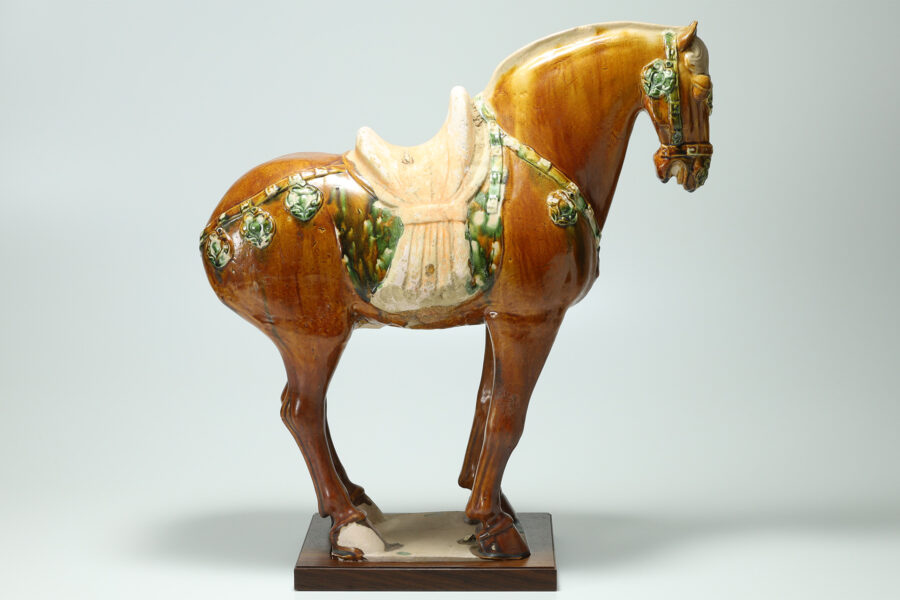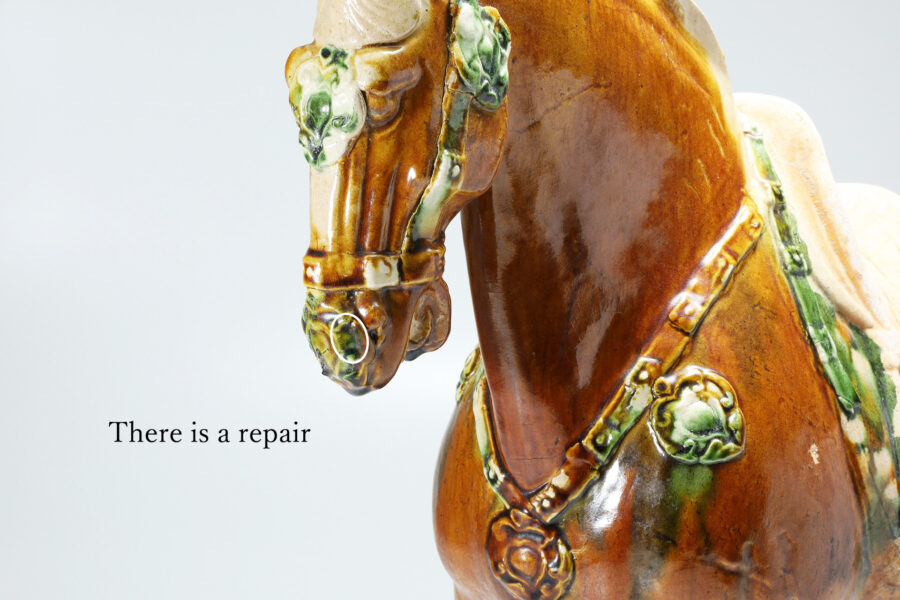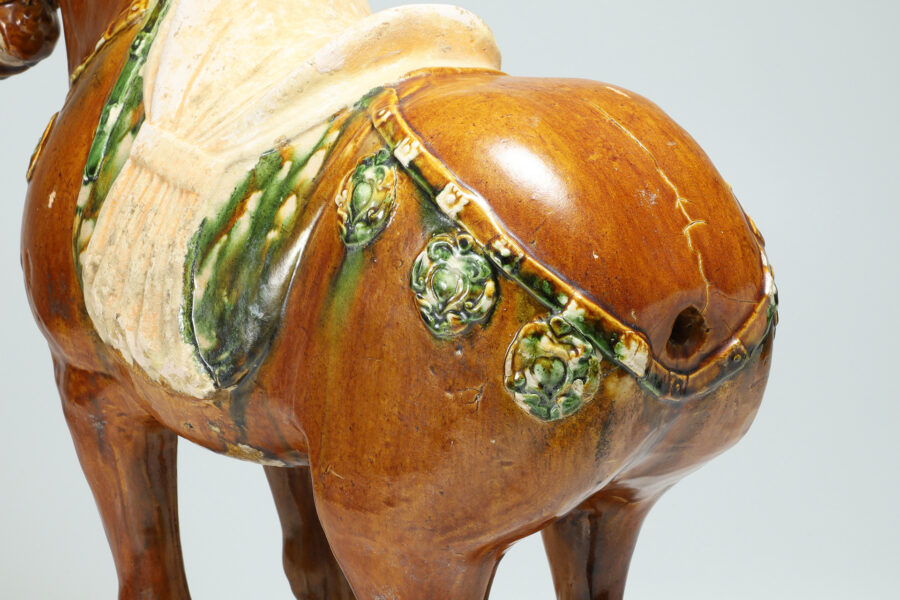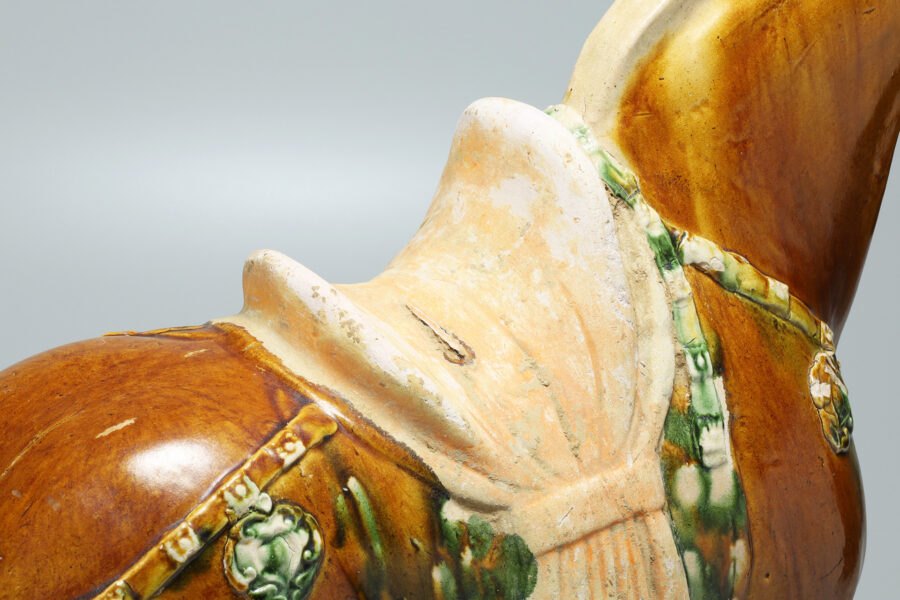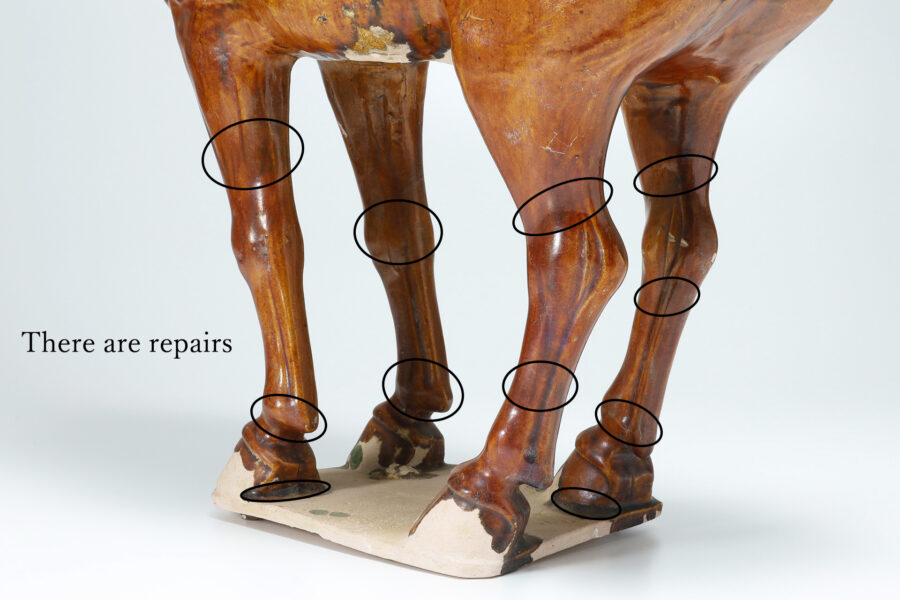Special Preview先行紹介
This is the masterpiece of horse figure with the most beautiful proportions among the tang-sancai animal figures. The bright and glossy three color glaze(white, green, and brown)and the dynamic and advanced molding techniques seem to confirm the prosperity of the tang dynasty culture. In japan, horse is regarded as "God's Vehicle" and is considered sacred animal. When offering prayers to the gods at shrines, a live horse was used to be offered as an offering, but instead of the expensive horse, people started offering a picture of a horse on a board. This is considered to be the beginning of votive picture. Horses have supported people's lives since ancient times, plowing fields, carrying heavy loads, and serving as inseparable partners. Sometimes it has come to have a meaning as a lucky charm that protects lives on the battlefield and brings "Victory", and it is also said to be necessary for warriors to achieve great achievements, as the word "Ride on a Winning Horse" means to arrive at an advantageous side.
Inquiry
- Product Code
- 240221-3
- Period
- Tang Dynasty
8th century
- Weight
- 4,570g
- Diameter
- 43.0×17.0cm
- Height
- 46.0cm
- Description
- Stand
Paulownia Box
- Condition
- There are repairs at the legs, ears, nose and ornaments
It meets the requirements of the first class work with its three color shades and glossy texture are excellent.
In ancient china, the afterlife was thought to be an extension of the present world. The life sized terracotta warriors surrounding the tomb of the first emperor of the qin dynasty are a representative example, but ceramic products continued to be buried in tombs afterward, even though the scale changed and the size was reduced.

Unlike the short horse breeds known in china up until then, with short necks and legs, this breed reflects the dashing appearance of today’s thoroughbreds. It can be seen that this is a famous horse born from a good bloodline originating from the west.

The entire work is covered with a dark brown glaze that gives it a beautiful luster, and the ornaments are expressed in three eye catching bright colors. The contact parts of each glaze fuse together to create a fantastic coloring.

The colored glazes used in tang-sancai use lead as a solvent and copper and iron as coloring agents. Lead glaze has existed since the han dynasty, but at that time there was still no beautiful white base available. With the development of whiter base and base technology that applied white makeup, the beauty of tang-sancai has made dramatic advances.

Horse figure is made using clay molds, and as they must go through a complicated and elaborate production process, they require extremely advanced techniques.

The interior is finished by a specialized upholsterer. It gives the box a neat appearance and makes it easier to place your work inside it.

Tang-Sancai
Tang-sancai is a type of three colored pottery that was fired during the tang dynasty mainly in kilns near xi’an (formerly chang’an)and luoyang. As a general rule, they were burial accessories and were not intended for everyday use. It is the work of art that gorgeously decorated the tombs of royalty and nobility, and is also a treasure symbolizing the cultural exchange between east and west along the exotic silk road. In 1905, a large amount of sancai was discovered during railway construction between kaifeng and luoyang, and the discovery of these richly colored burial accessories, which had been virtually unknown until then, astounded the world. It was competitively sought after by collectors in europe and the united states, and quickly became a representative of chinese ceramics. Although there was a trend in japan to avoid burial accessories, collectors who were fascinated by the beauty of sansai gradually appeared, and a new style of ceramics collecting called “Appreciation Ceramics” was established, in which people purely admired the beauty of ceramics. Moritatsu Hosokawa(Eisei Bunko Museum), Koyata Iwasaki(Seikado Bunko Art Museum), Tamisuke Yokogawa(Tokyo National Museum Collection), and Sazo Idemitsu(Idemitsu Museum of Arts)are known as central figures who collected tang-sansai. By far the most examples of excavations have been found in xi’an in shaanxi province and luoyang in henan province, which were home to royalty and high ranking officials, followed by yangzhou in jiangsu province, which was a trading port. With the progress of excavations, the excavated area continues to expand, and it has spread to liaoning, hebei, shanxi, shandong, gansu, hubei, anhui, jiangxi, and other provinces, making it a fairly wide ranging distribution. After shaping the highly plastic clay, it is bisque fired at a high temperature of approximately 1,200℃. After cooling, a basic glaze(transparent glaze)is applied, green or brown lead glaze is added, and low temperature firing is performed at approximately 800-900℃. The colored glaze flows or bleeds because the base glaze becomes the base melt during firing, and the parts of each glaze that come in contact with each other fuse together, giving off a gorgeous color. Basically, there are three colors(white, green, and brown), but works that include blue and two colors with fewer colors are also collectively referred to as “Tang-Sansai”. It had a great influence on the ceramic industries of surrounding countries, including its own country’s “Liao-Sancai” and Japan’s “Nara-Sancai”, as well as “Silla-Sancai” and “Bohai-Sancai”.





